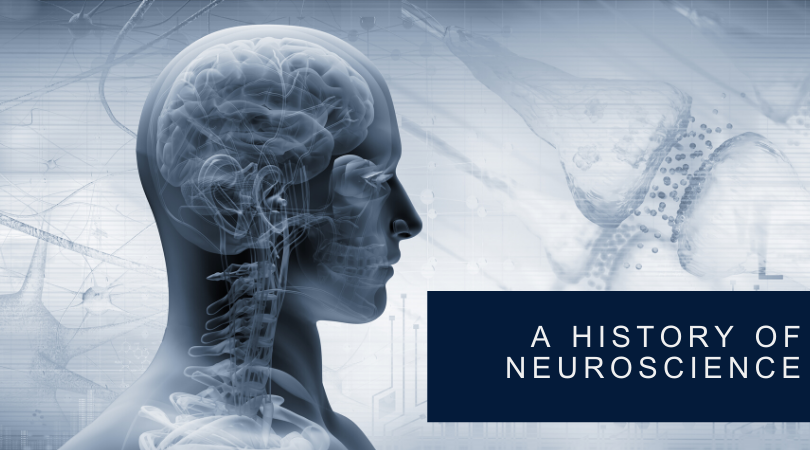The Evolution of Neuroscience
Posted on
The work of scientists and researchers in the field of neuroscience—the study of the structure or function of the nervous system and brain—has produced important knowledge about the brain and nervous system and made medical breakthroughs that significantly improve human health.
 Though the brain was identified as the source of intelligence as early as the 6th century B.C. and neuroscience has been practiced all the way back to ancient civilizations, modern neuroscience has experienced a fairly dramatic resurgence within the last 20 years, with many major discoveries about how the brain works and what role it plays in different neurological diseases and disorders.
Though the brain was identified as the source of intelligence as early as the 6th century B.C. and neuroscience has been practiced all the way back to ancient civilizations, modern neuroscience has experienced a fairly dramatic resurgence within the last 20 years, with many major discoveries about how the brain works and what role it plays in different neurological diseases and disorders.
“I feel really sorry for the people who retired five years ago,” said Michael Stryker, a neuroscientist at the University of California, San Francisco, in a 2014 article in Scientific American. “Neuroscience now is a completely different world from how it used to be.”
In the last 20 years, neuroscientists have made groundbreaking discoveries including:
- Identifying single gene defects that contribute to neurological disorders
- Understanding how the brain reacts to social stimuli
- The discovery that the brain is highly malleable, even into adulthood
- The use of brain-computer interfaces to establish direct communication between the brain and an external device
- Uncovering the biochemical processes that determine how memories are formed and accessed
- Discovering the role of glial cells in key brain functions
- The development of neural implants for degenerative eye conditions, and the exploration of implantable therapies for Parkinson’s disease, epilepsy, addiction, and chronic pain
Fueling many of these discoveries was the Human Genome Project, which sequenced and mapped our genes in 2001, and the NIH Blueprint For Neuroscience Research, a group of 14 NIH Institutes and Centers that support and advance the area of neuroscience, which was established In 2004.
In 2013, the Blueprint became one of the inaugural sponsors of the BRAIN (Brain Research through Advancing Innovative Neurotechnologies) Initiative, a public-private research initiative created by the Obama administration to help researchers learn more about brain disorders such as Alzheimer's, Parkinson's, depression, and traumatic brain injury.
While many brain-related discoveries have involved human subjects, some of the most important have used mouse models.
Major Neuroscience Discoveries Using Mice
In the past, studies of the brain and nervous system had to be done on humans, which meant either passive observation of living subjects or post-mortem study of brains in deceased subjects. The use of mice in neuroscience was an important advance that enabled scientists to essentially create a type of human brain network in living mice in order to study the workings of a live “human” brain. The incorporation of mouse models into neuroscience, often using stereotactic surgery, has led to many important discoveries.
- University of California, Irvine researchers developed a way for human brain immune cells called microglia to grow and function in mice, giving scientists an unprecedented view of how key human brain cells respond to neurological conditions such as Alzheimer's, Parkinson's, traumatic brain injury, and stroke.
- Using optogenetics, a method of controlling cells in living tissues with light and genetics, neuroscientists at the Stanford University School of Medicine were able to activate individual neurons in live and alert mice. Seven years later, the same team used optogenetics to activate nerve cells in the visual cortex to trigger hallucinations in mice, which may provide insight into hallucination-causing mental illnesses such as schizophrenia, Alzheimer’s, Lewy body dementia, bipolar disorder, and more.
- Researchers at the University of Copenhagen studying mice with human glial cells found a genetic defect that could be a cause of schizophrenia and other brain disorders.
- In studying microbe-free mice, scientists at the APC Microbiome Institute at University College Cork in Ireland found that gut microbes can affect the functioning of the brain and nervous system and contribute to stress-related psychiatric disorders, anxiety, and depression.
- By studying mouse brains, researchers at Washington University School of Medicine not only found a connection between the buildup of amyloids and the development of Alzheimer's, they discovered a way to potentially treat or prevent Alzheimer’s by changing the way the brain uses lipids, and developed a blood test that could detect early brain changes that may lead to Alzheimer’s.
- Using genetically engineered mouse models, researchers in Memorial Sloan Kettering’s Brain Tumor Center identified a drug, dubbed Gboxin, that kills glioblastoma cells in mice without injuring healthy cells.
- Scientists at the Massachusetts Institute of Technology were able to create false memories in mice by identifying the specific brain cells involved in encoding a single memory, and manipulating them to create a new “memory” of an event that never happened.
- A link between exercise and cognition was uncovered by scientists at Hokkaido University in Sapporo, Japan, who found that mice display improved memory after swimming or running on treadmills.
Fortunately, neuroscience discoveries continue to accelerate, backed by increasing investment in brain-related research and an upcoming generation of neuroscientists being trained in newly added undergraduate neuroscience degrees at schools including the University of Buffalo, Boston College, West Virginia University, University of North Carolina, George Washington University, Yale, Christopher Newport University, the University of South Dakota, the University of Maryland, the University of Montana, Bethel University, Indiana University Northwest, and the University of Wisconsin-Eau Claire.
As interest and expertise in the field of neuroscience continues to increase, we can expect many more exciting discoveries in the years to come.